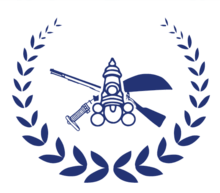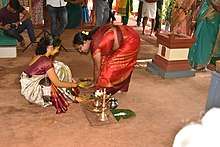Tulu Gowda
Tulu Gowda and Kodagu Gowda (Gauda) are the subsect of the Vokkaliga community located primarily in the South Canara District, Kodagu District, Indian state of Karnataka.[1][2]
 Emblem of Tulu and Kodagu Gowda | |
| Regions with significant populations | |
|---|---|
| Dakshina Kannada, Coorg | |
| Languages | |
| Tulu and Arebhashe dialect | |
| Religion | |
| Hinduism |
Etymology
The root of Gauḍa/Gowda is a Dravidian word meaning a mountain Or village head. One who speaks accommodate in Tulunadu are called Tulu Gowda, they speak Arebhashe and kannada
Caste Government

They have a somewhat elaborate system of caste government. In every village there are two headmen, the Grāma Gowda and the ottu Gauda. For every group of eight or nine villages there is another head called the Māganē Gauda, and for every nine Māganēs there is a yet higher authority called the Kattēmanēyava.[3]
Bari Paddati
.jpg)
The caste is divided into eighteen baris or balis, which are of the usual exogamous character, same bari men, women not to marry, they belongs to close cousins. The caste is divided into eighteen baris or balis, which are of the usual exogamous character. The names of some of these are as follows: Bangāra (gold), Nandara, Malāra (a bundle of glass bangles, as carried about for sale), Sālu, Hemmana (pride or conceit), Kabru, Gōli (Portulaca oleracea, a pot-herb), Basruvōgaru (basru, belly), Balasanna, Kabar, Gundana, Chalyera, Mulyera, Nayera and Karmannāya.
Arsaya
Once a year, mostly in the tulu month of Kaarthel (June–July), the Gaudas perform a ceremony for the propitiation of all deceased ancestors. They have a special preference for Venkatarāmaswāmi, to whom they make money offerings once a year in September. It should be reach Tirupati as a offering, which mostly includes coins, pepper, rupee notes.[4]
History
They were originally called Natha Pantha and Shaivas, owing allegiance to Sringeri Matha. During Emperor Vishnuvardhana’s rule, they became Vaishnavites and worshiped Tirupati Thimmappa (Balaji of Tirupati) and Sabbakka (Sharada of Sringeri). They then settled in the Mangalore-Udupi (Dakshina Kannada-Udupi) region where they spoke the Tulu language. They are said to have 10 Kutumba and 18 Bari as their primordial root families, from which a Nūru Mane or "hundred families" arose. Many of these families settled in Kodagu from the time of Talakadu Gangas (200 - 1004 CE),[5] under Kodagu's rule. They then migrated to Coorg (Kodagu) from the Mangalore-Udupi (Dakshina Kannada-Udupi) region, to settle among the Canarese (Kannada) speaking peoples.[6]
Indian national Freedom movement
The Gowdas were historically involved in a rebellion against British rule in Canara and Coorg. Guddemane Appayya Gowda, whose family was given lands in Kodagu, along with others from Kodagu and Kedambadi Rame Gowda from Sulya rebelled against the British and hoisted Jangama (Lingayite monk) Kalyanaswamy's flag in Bavuta Gudde in Mangalore and ruled for 13 days. This was one of the earliest Indian independence struggles against British rule 1834.[7][8][9]
References
- Gowda, Aravind (15 September 2011). "Caste war heats up as Sadananda isn't Gowda enough". India Today. Retrieved 27 January 2019.
- Gough, Kathleen (2008). Rural Society in Southeast India. Cambridge University Press. ISBN 978-0-521-04019-8.
- Castes and Tribes of Southern India/Gauda
- Valase, Sangarsha, Samanvaya By Purushothama Bilimale, Akruthi Publication Mangaluru, 2019 Pg: 216
- Puttur Anantharaja Gowda (2015). "IN PURSUIT OF OUR ROOTS". Bengaluru: Tenkila Publications
- Dr. Kodi Kushalappa Gowda (1976). Gowda Kannada. Annamalai University.
- Karnataka / Madikeri News : Appaiah Gowda memorial to honor freedom fighter. The Hindu. Retrieved 23 July 2016.
- Account of an uprising. Deccan Herald. Retrieved 23 July 2016.
- Fate of the insurgents. Deccan Herald. Retrieved 23 July 2016.
Further reading
| Wikisource has original text related to this article: |